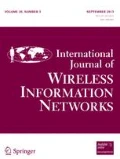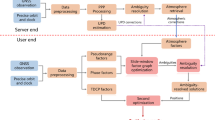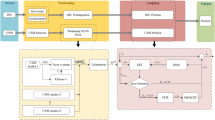Abstract
Location detection is a very important issue in a wireless environment, allowing realisation of several useful services linked to the knowledge of the position of a mobile user (e.g. path optimisation, management of field crew in a large plant, providing a mobile robot with autonomous capabilities). Literature presents many approaches for location detection of a mobile device in a WLAN. One of these is based on the use of a pattern matching algorithm which provides for the position of the mobile device given the Radio Signal Strength (RSS) values received by it. Generally, localisation in WLAN environment is limited to indoor scenarios. Although GPS is commonly used for outdoor location detection, localisation in a WLAN communication infrastructure may be realised also for outdoor areas. The main advantage is a save in the hardware needed for the localisation, as it only requires the use of the WLAN communication card; further, the current limits of GPS, which may introduce not negligible errors in outdoor location detection, encourages the investigation of other techniques for outdoor localisation. On account of what said, the first aim of the paper is to investigate the feasibility of outdoor localisation of a mobile device in a WLAN environment; an IEEE 802.11b-based WLAN will be considered. Outdoor localisation has been realised using a pattern matching algorithm and the relevant performance, measured in terms of location errors, has been evaluated and compared with that commonly provided for by a GPS device. Then the paper will present a proposal for localisation, aimed to reduce the complexity typically featured by the pattern matching algorithm based approach when used for wide areas; the proposal is based on the use of a signal propagation model able to predict the RSS values available in each position of a IEEE 802.11b WLAN. Performance of the novel approach has been evaluated for outdoor localisation and the main results achieved will be shown in the paper. Finally, use of a Kalman filter for the location detection, will be presented in order to improve the performance of the pattern matching algorithm, making this technique very attractive for outdoor use.













Similar content being viewed by others
References
A. Harter, A. Hopper, P. Steggles, A. Ward, and P. Webster, The anatomy of a context-aware application, Proceedings of the 5th Annual ACM/IEEE International Conference on Mobile Computing and Networking, MOBICOM 1999, Seattle, Washington, pp. 59–68, August 1999.
T. W. Christ and P. A. Godwin, A prison guard duress alarm location system, Proceedings of the IEEE International Carnahan Conference on Security Technology, October 1993.
J. Werb and C. Lanzl, Designing a positioning system for finding things and people indoors, IEEE Spectrum, Vol. 35, No. 9, pp. 71–78, 1998.
I. Cox, Blanche – an experiment in guidance and navigation of an autonomous robot vehicle, IEEE Transactions on Robotics and Automation, Vol. 7, No. 2, pp. 193–204, 1991.
A. Ward, A. Jones, and A. Hopper, A new location technique for the active office, IEEE Personal Communication, Vol. 4, pp. 42–47, 1997.
R. J. Fontana and S. J. Gunderson, Ultra-wideband precision asset location system, Proceedings of the IEEE Conference on Ultra Wideband Systems and Technologies, Baltimore, Maryland, pp. 147–150, May 21–23, 2002.
R. Want, A. Hopper, V. Falcão, and J. Gibbons, The active badge location system, ACM Transactions on Information Systems, Vol. 10, pp. 91–102, 1992.
N. B. Priyantha, A. Chakraborty, and H. Balakrishnan, The cricket location support system, Proceedings of the 6th Annual ACM International Conference Mobile Computing and Networking, Boston, Massachusetts, pp. 32–43, August 6–11, 2000.
http://www.grouper.ieee.org/groups/802/11. Accessed on 5 July 2007.
K. Pahlavan, L. Xinrong, and J.-P. Makela, Indoor geolocation science and technology, IEEE Communications Magazine, Vol. 40, No. 2, pp. 112–118, 2002.
P. Bahl and V. N. Padmanabhan, RADAR: an in-building RF-based user location and tracking system, Proceedings of IEEE Infocom 2000, Tel-Aviv, Israel, pp. 775–784, March 23–26, 2000.
P. Bahl, V. N. Padmanabhan, and A. Balachandran, Enhancements to the RADAR user location and tracking system, Technical Report, MSR-TR-2000-12, 2000.
I. Guvenc, Enhancements to RSS based indoor tracking systems using Kalman filters”, MS Thesis, 2002, http://www.eece.unm.edu/~ismail/ismail_tez1.pdf.
M. Brunato and C. Kiss Kalló, Transparent location fingerprinting for wireless services, Proceedings of Med-Hoc-Net, Mediterranean Workshop on Ad-hoc Networks, Baia Chia, Cagliari, September 2002.
T. P. Deasy and W. G. Scanlon, Stepwise algorithm for improving the accuracy of both deterministic and probabilistic methods in WLAN-based indoor user localisation, International Journal of Wireless Information Networks, Vol. 11, No. 4, pp. 207–216, 2004.
http://www.amt.catania.it/. Accessed on 5 July 2007.
H. M. El-Sallabi, W. Zhang, and P. Vainikainen, An efficient technique for modeling wideband propagation in an urban parallel street microcellular environment, IEEE Antennas and Propagation Society International Symposium, Vol. 3, pp. 1490–1493, 11–16 July 1999.
D. Har, H. H. Xia, and H. L. Bertoni, Path-loss prediction model for microcells, IEEE Transactions on Vehicular Technology, Vol. 48, No. 5, pp. 1453–1462, 1999.
H. H. Xia, A simplified analytical model for predicting path loss in urban and suburban environments, IEEE Transactions on Vehicular Technology, Vol. 46, No. 4, pp. 1040–1046, 1997.
H. L. Bertoni, W. Honcharenko, L. R. Macel, and H. H. Xia, UHF propagation prediction for wireless personal communications, Proceedings of the IEEE, Vol. 82, No. 9, pp. 1333–1359, 1994.
http://www.lx.it.pt/cost231/final_report.htm. Accessed on 5 July 2007.
W. C. Y. Lee and D. J. Y. Lee, Microcell prediction in dense urban area, IEEE Transactions on Vehicular Technology, Vol. 47, No. 1, pp. 246–253, 1998.
K. J. Gladstone and J. P. McGeehan, Computer simulation of multipath fading in the land mobile radio environment, IEE Proceedings, Vol. 27, Pt.G, No. 6, pp. 323–330, December 1980.
J. W. McKown and R. L. Hamilton, Ray-tracing as a design tool for radio networks, IEEE Network Magazine, pp. 21–26, November 1991.
K. S. Schaubach, N. J. Davis, and T. S. Rappaport, A ray-tracing method for predicting path loss and delay spread in microcell environments, Proceedings of the 1992 IEEE Vehicular Technology Society Conference, Denver, pp. 932–935, May 1992.
M. C. Lawton and J. P. McGeehan, The application of GTD and ray launching techniques to channel modelling for cordless radio systems, Proceedings of the 1992 IEEE Vehicular Technology Society Conference, Denver, pp. 125–130, May 1992.
H. R. Anderson, A Ray Tracing propagation model for digital broadcast system in urban area, IEEE Transactions on Broadcasting , (T-BC), Vol. 39, No. 3, pp. 309–317, 1993.
R. G. Kouyoumjian and P. H. Pathak, A uniform geometric theory of diffraction for an edge on a perfectly conducting surface, Proceedings of IEEE, Vol. 62, No. 11, pp. 1448–1461, 1975.
S. K. Kandasamy, M. Ismail, and S. K. Tiong, Application of genetic algorithm for large scale coverage prediction in GSM cellular mobile system, M 2 USIC 2004, TS6C-3, pp. 9–13, 2004.
I. Guvenc, C. T. Abdallah, R. Jordan, and O. Dedeoglu, Enhancements to RSS based indoor tracking systems using Kalman filters, International Signal Processing Conference (ISPC) and Global Signal Processing Expo (GSPx), Dallas, TX, March 31–April 3, 2003.
E. P. Herrera, R. Quiros, G. Fabregat, M. Ribo, and A. Pinz, Pedestrian localization system based on Kalman filter and fuzzy logic, 5th IEEE Conference on Sensors, pp. 1183–1186.
K. Sreenath, F. L. Lewis, and D. O. Popa, Simultaneous adaptive localization of a wireless sensor network, ACM SIGMOBILE Mobile Computing and Communications Review, Vol. 11, No. 2, pp. 14–28, 2007.
P. S. Maybeck, Stochastic Models, Estimation and Control, Vol. 1, Academic Press Inc., 1979.
M. S. Grewal and A. P. Andrews, Kalman Filtering Theory and Practice, ISBN 013211335X, Prentice Hall, 1993.
G. Bishop and G. Welch, An introduction to the Kalman filter, Proceedings ACM SIGGRAPH 2001, course 8, Los Angeles, August 2001.
H. W. Sorenson, Least-squares estimation: from Gauss to Kalman, IEEE Spectrum, 7, pp.63–68, 1970.
Author information
Authors and Affiliations
Corresponding author
Rights and permissions
About this article
Cite this article
Cavalieri, S. WLAN-based Outdoor Localisation Using Pattern Matching Algorithm. Int J Wireless Inf Networks 14, 265–279 (2007). https://doi.org/10.1007/s10776-007-0067-0
Received:
Accepted:
Published:
Issue Date:
DOI: https://doi.org/10.1007/s10776-007-0067-0




